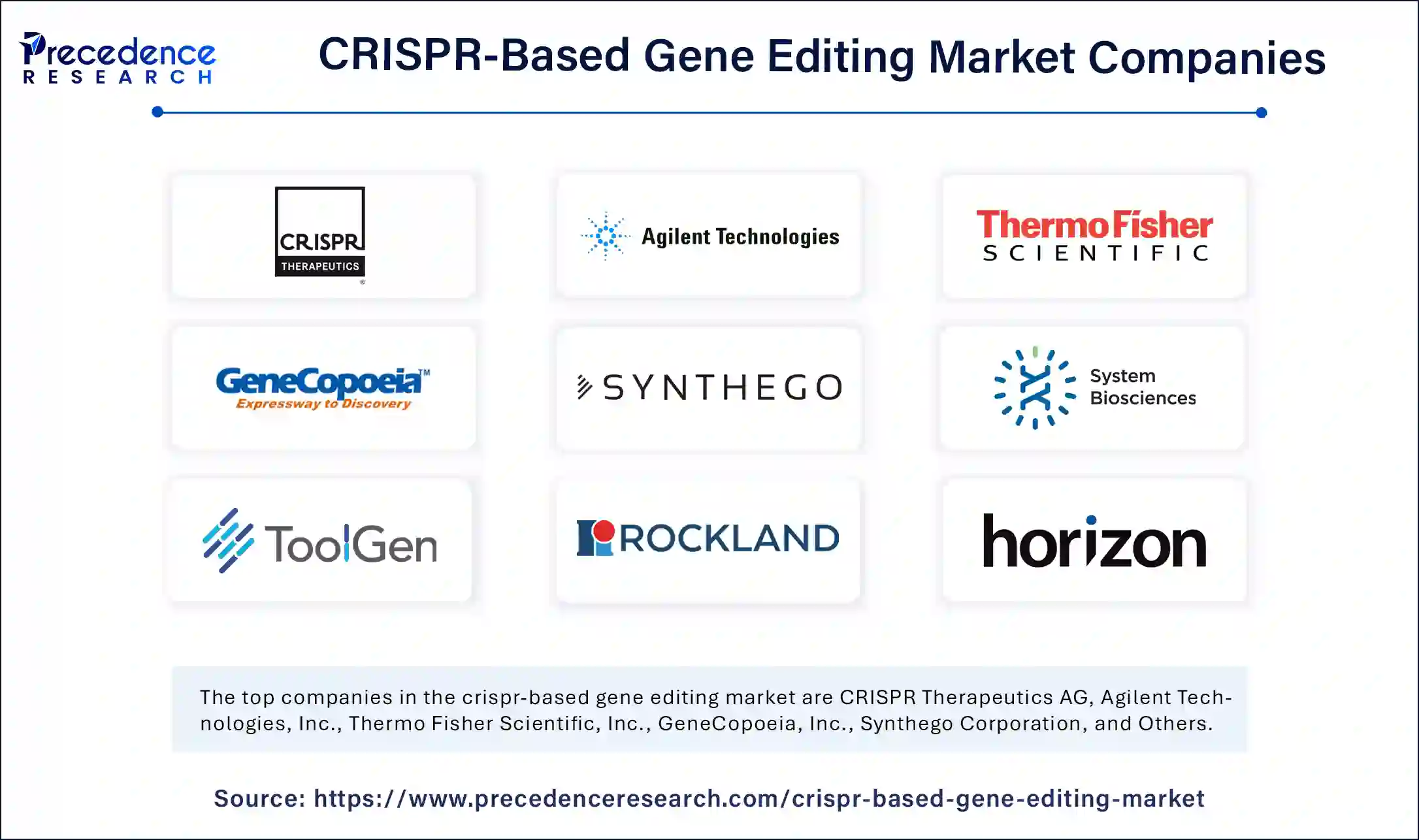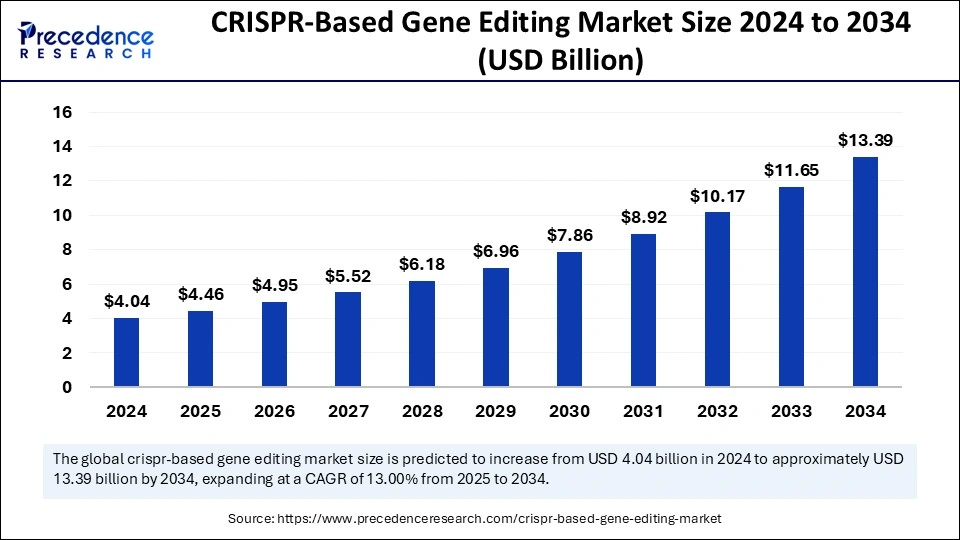The global CRISPR-based gene editing market size is expected to attain around USD 13.39 billion by 2034 increasing from USD 4.04 billion in 2024, with a CAGR of 13.00%.
Get a Free Sample Copy of the Report@ https://www.precedenceresearch.com/sample/5781
CRISPR-Based Gene Editing Market Key Highlights
-
North America commanded the gene editing space in 2024 with a 41.15% market share.
-
Asia Pacific is emerging as a key growth hub, expected to rise at 15.18% CAGR.
-
Among products, kits and reagents were the top-selling, comprising 77% of the market.
-
Services in gene editing are growing quickly, with a forecasted CAGR of 14.4%.
-
Ex vivo editing remained the preferred gene editing approach with 53% market control.
-
In vivo editing is expanding rapidly, seeing the fastest CAGR at 12.5%.
-
CRISPR/Cas9 technology led the tech segment with a strong 55% share.
-
CRISPR/Cas12 is on the rise with a 12.3% CAGR, suggesting increased demand.
-
Therapeutics was the primary application area, making up 64.05% of usage.
-
The agricultural and livestock space is catching up with 14.3% projected growth.
-
Biotech and pharmaceutical companies were the top consumers, with a 42% share.
-
The agriculture sector is scaling up adoption, growing at a pace of 14.3% CAGR.
The Role of AI in the CRISPR-Based Gene Editing Market
Artificial Intelligence (AI) is playing a transformative role in advancing CRISPR-based gene editing technologies. By enhancing precision, efficiency, and scalability, AI is accelerating innovation across gene therapy, diagnostics, agriculture, and drug discovery. Here’s how:
-
Target Site Prediction and Optimization
AI algorithms analyze vast genomic datasets to accurately predict CRISPR target sites. This helps researchers design guide RNAs (gRNAs) with high specificity and minimal off-target effects, significantly improving the safety and effectiveness of gene editing procedures. -
Off-Target Risk Minimization
One of the biggest challenges in CRISPR editing is unintended off-target mutations. AI-powered models can forecast and flag potential off-target sites across the genome, enabling scientists to refine their approaches and reduce errors. -
Automated CRISPR Design Platforms
AI tools are streamlining the process of designing CRISPR experiments by automating guide RNA selection, vector construction, and delivery mechanism planning. These platforms save time and lower the barriers for gene editing experimentation. -
Predictive Modeling in Gene Therapy
AI is helping predict how CRISPR edits will impact specific genes and cellular pathways. These predictive insights aid in selecting optimal therapeutic targets and customizing treatments for individual patients. -
Data Analysis and Interpretation
CRISPR experiments generate large volumes of sequencing and phenotypic data. AI is crucial for organizing, analyzing, and interpreting this information—uncovering patterns and results that would be hard to detect manually. -
Drug Discovery and Development
Combining AI with CRISPR allows rapid screening of gene functions and potential drug targets. This synergy is revolutionizing the speed and accuracy of preclinical trials and personalized medicine development. -
Advancing Agricultural Biotechnology
AI helps in identifying traits for crop improvement, enabling precise genome edits in plants for better yield, pest resistance, and climate resilience through CRISPR tools. -
Enhancing Synthetic Biology and Functional Genomics
AI is used to simulate genome-wide effects of edits, enabling more reliable synthetic biology designs and functional genomics studies using CRISPR systems.
CRISPR-Based Gene Editing Market Growth Factors
-
Rising Demand for Precision Medicine
The growing need for targeted and personalized treatments is accelerating the adoption of CRISPR technology, which allows precise gene modifications to treat genetic disorders, cancers, and rare diseases. -
Advancements in Biotechnology and Genomics
Rapid developments in sequencing technologies, bioinformatics, and synthetic biology are enhancing the accuracy and scalability of CRISPR applications, fueling market growth. -
Increasing R&D Investments
Both public and private sectors are heavily investing in CRISPR research and therapeutic development, especially in areas like oncology, neurology, and inherited diseases. -
Expanding Applications in Agriculture and Livestock
CRISPR is being widely adopted to develop genetically modified crops with improved yields, pest resistance, and drought tolerance, as well as in livestock to enhance productivity and disease resistance. -
Growing Collaborations and Licensing Agreements
Strategic partnerships between biotech companies, research institutions, and pharmaceutical firms are fostering innovation, accelerating clinical trials, and expanding commercial access to CRISPR tools. -
Supportive Government Initiatives and Funding
Governments across the globe are promoting genome editing technologies through grants, subsidies, and regulatory support, encouraging wider adoption of CRISPR in healthcare and agriculture. -
Emergence of AI and Computational Tools
The integration of AI is streamlining CRISPR design, predicting off-target effects, and automating large-scale experiments—boosting the overall efficiency and reliability of gene editing processes. -
Rising Prevalence of Genetic Disorders
Increasing incidence of genetic diseases such as sickle cell anemia, cystic fibrosis, and Huntington’s disease is creating a strong demand for effective gene therapies based on CRISPR. -
Commercialization of CRISPR-based Products
Launches of CRISPR-based diagnostic kits, cell and gene therapies, and agricultural solutions are creating new revenue streams and expanding market reach globally. -
Regulatory Advancements and Approvals
Positive regulatory changes and accelerated approval pathways for gene therapies are improving the market outlook and fostering confidence in the technology.
Market Scope
| Report Coverage | Details |
| Market Size by 2034 | USD 13.39 Billion |
| Market Size in 2025 | USD 4.46 Billion |
| Market Size in 2024 | USD 4.04 Billion |
| Market Growth Rate from 2025 to 2034 | CAGR of 13.00% |
| Dominating Region | North America |
| Fastest Growing Region | Asia Pacific |
| Base Year | 2024 |
| Forecast Period | 2025 to 2034 |
| Segments Covered | Product, Gene Editing Modality, Technology, Application, End User, and Regions. |
| Regions Covered | North America, Europe, Asia-Pacific, Latin America, and Middle East & Africa |
Market Dynamics
Market Drivers:
Key market drivers include increased prevalence of genetic diseases, advancements in CRISPR-Cas technologies, and the acceleration of clinical trials focusing on gene therapy and regenerative medicine.
Opportunities:
New possibilities are emerging in areas like gene therapy for rare diseases, CRISPR-modified crops for food security, and industrial biotech applications such as microbial strain improvement.
Challenges:
Challenges persist around the safety and specificity of CRISPR applications. Regulatory uncertainties and ethical debates over editing human embryos also pose significant hurdles for widespread implementation.
Regional Outlook:
North America remains the dominant region, benefiting from a concentration of biotech companies and funding agencies. Europe continues to support innovation, especially in agricultural gene editing. Asia-Pacific is showing strong momentum with increasing R&D and public-private partnerships in biotechnology.
CRISPR-Based Gene Editing Market Companies

- CRISPR Therapeutics AG
- Agilent Technologies, Inc.
- Thermo Fisher Scientific, Inc.
- GeneCopoeia, Inc.
- Synthego Corporation
- System Biosciences LLC
- ToolGen, Inc.
- Rockland Immunochemicals, Inc.
- Horizon Discovery Group PLC
- Abcam, Inc.
- Applied StemCell, Inc.
- Cellecta, Inc.
Recent Developments
- In January 2025, scientists at the Institute of Cancer Research (ICR) in the UK developed a method for simultaneous activation, repression, and knockout of genes within a single cell by using CRISPR technology.
- In January 2025, researchers in the UK and the United States published a study about the use of prime-editing technology to insert recombinase sites into repetitive DNA sequences, exploring the human genome’s structural flexibility. This study allows scientists to create genomic rearrangements in human cell lines, including deletions, inversions, and translocations across all chromosomes.
Segment Covered in the Report
By Product
- Kits and Reagents
- CRISPR Kits
- Guide RNA
- Enzymes
- Other Reagents
- Services
- Gene Editing Services
- Contract Research Organizations (CROs)
By Gene Editing Modality
- Ex-Vivo Editing
- In-Vivo Editing
By Technology
- CRISPR/Cas9 Technology
- CRISPR/Cas12 Technology
- CRISPR/Cas13 Technology
- Base Editing
- Prime Editing
- Epigenetic Editing
- Others
By Application
- Therapeutic Applications
- Gene Therapy
- Cancer Therapy
- Infectious Disease Treatment
- Regenerative Medicine
- Agriculture and Livestock
- Crop Improvement
- Livestock Modifications
- Industrial Biotechnology
- Microbial Engineering
- Biomanufacturing
By End User
- Academic and Research Institutes
- Biotechnology and Pharmaceutical Companies
- Agricultural and Livestock Industry
- Hospitals and Clinics
- Contract Research Organizations (CROs)
By Geography
- North America
- Europe
- Asia Pacific
- Latin America
- Middle East and Africa
Also Read: Vendor Neutral Archive and PACS Market
Ready for more? Dive into the full experience on our website@ https://www.precedenceresearch.com/

